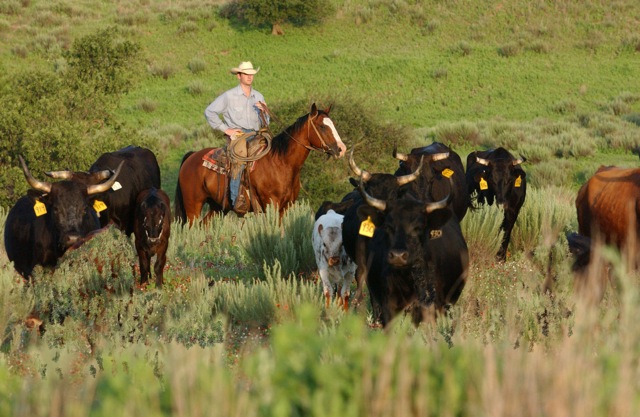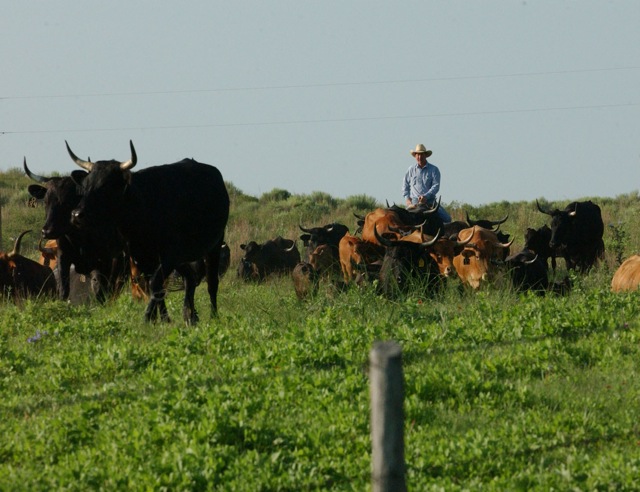
cattledrive, l
(article, Deborah Madison)
After breathing in the seductively fragrant smells emanating from a lineup of grills cooking grass-fed beef, people can't wait to pay their $10 to take part in a unique tasting of local meat. Tickets in hand, they enter the huge old alumni hall on the local college campus, and the smells that greet them there are as tempting as those they had encountered outside. Roast heritage turkeys with dark, succulent meat, tender braised rabbit, grilled lamb, Thai beef salads, sliders, and savory briskets competed with one another for top billing, but fortunately no one had to choose. All those meats are there to be tasted. And along with the sampling, the public has a rare opportunity to talk with the ranchers who raise animals for food. [%image "reference-image" float=left width=400 caption="Corriente cattle roam the range in New Mexico, eating grass along the way."] As chefs serve up their fare, ranchers are free to introduce themselves and talk about what they do. So while savoring a tasty mouthful, one can learn about these ranchers’ animals, from Rio Grande wild turkeys to Label Rouge chickens, from bison to Highland cattle, from Churro lamb to Black Angus beef. Ranchers talk about how their animals are raised, what grass-fed means to those whose animals are range-fed, and most importantly, how to enjoy these deeply wholesome foods at home. The scene is Sante Fe's second annual round-up of local flavors and livestock tasting — with 500 people attending, it is double the size of last year’s event. There’s clearly a hunger to learn where the protein on our plates comes from. To make it easier to imagine, home freezers are on display. One of them, plus some generous coupons to spend on meat, are raffled off. The kids, less interested than their parents in this whole thing, have a corner where they can hone their roping skills with an expert teacher. A lively little country duet warms the hall, and periodically, ranchers are introduced to an enthusiastic crowd and interviewed. h3. Marketing meats The melodic chord that has rung for so long in praise of produce is just beginning to be heard for local meats. Meats didn’t appear in farmers’ markets right away — they followed cheese and dairy once the vegetable part got going — but today a great many of our farmers’ markets serve as a hospitable showcase for the highest quality meat to be had in the nation. Farmers’ markets are the place to shop for meat with flavor, often from grass-fed animals — definitely not feedlot-produced. It’s meat that’s humanely raised, and is traceable and safe to eat. In my Santa Fe farmers’ market alone, for example, we can now buy grass-fed beef, Navajo-Churro lamb, pastured poultry (chicken, turkey, duck, eggs), and bison. But there are many more producers in New Mexico raising first-rate livestock, and in part, this tasting is to introduce them and their products to the public. Ranching in the arid west tends to require a lot of open space, which means ranches are frequently far from urban centers. One of the obstacles to the direct marketing offered by the farmers’ market is the four- or five-hour drive to a market that opens at 7 a.m., followed, of course, by the drive home. This just isn’t doable for most ranchers. But what these ranchers can do is sell their animals to individuals. The animals are slaughtered in an inspected slaughterhouse, butchered in an approved facility, then mailed to the customer, a box of neatly wrapped, labeled, and frozen parcels. Once you meet a rancher whose meat you like, and once you sit down and figure out what kinds of cuts you want, the rest is easy. And it’s hard to give up once you’ve got it going. One rancher, Nancy Ranney, jokes that their customers become “Ranney spoiled.” They just don’t want to eat any other kind of beef once they’ve become accustomed to her tender Angus beef. And every rancher has his or her following. h3. The return of the meat locker? This shopping method, however, is one that few people are versant with today. Once it was seen as a practical and fairly efficient way of dealing with one’s meat supply. From the 1930s through the 1960s the meat locker was a part of America’s food life. Often found in butcher shops, such freezer spaces were rented by the year. In those times, people knew more than they do today about buying wholes or halves of beeves and butchering and freezing game that was also destined for the meat locker. [%image cattledrive float=right width=500 caption="Selling meat directly to customers via previous arrangement usually makes more sense for ranchers than selling at the farmers' market."] Another thing people knew then was how to cook shanks and oxtails, make stocks from bones, and produce succulent roasts and other large cuts of meat. Today our in-a-hurry lifestyle favors fast-cooking hamburger, steaks, and chops, not frozen, of course. (Bigger cuts are not fast cooking.) Like remembering to soak beans, defrosting meat requires some forethought. Once it’s defrosted, a roast wants a long, slow cooking time on the stove, in the oven, or in a Crock-Pot. In fact, the Crock-Pot is a great answer to the question of what to do with oxtails and arm roasts and pot roasts. A rancher from Texas once said to me, “I feel so sorry for these young people who don’t know what they can do with a Crock-Pot! All they have to do is throw that roast in there and when they come home from work \[or off the range, in his case\], they’ll sit down to the best dinner they can have — and have leftovers, too.” The Sante Fe event featured some of these larger cuts to remind people how good they are. While you can order your beef or lamb to be rendered into nothing but steaks and ground meat if that’s what you want, there’s something to be said for getting to know the cuts our parents and grandparents cooked. These old-fashioned cuts make some of the most savory winter dishes you can imagine. Many people have never tasted rabbit, an animal that is greeted with much resistance usually for sentimental reasons. But at the Sante Fe event they had a chance to, and it was voted one of the best-liked meats. The rancher who raised the rabbit found a solid customer in the chef who prepared it. He also had 40 people sign up for his Rio Grande wild turkeys for Thanksgiving. [%image fence float=left width=500 caption="Ranchers are once again establishing relationships with customers who want their grass-fed beef."] Another ranch made a great contact with the chef who cooked his beef, and was approached by five other restaurants to supply them with organic grass-fed beef as well. Another was approached by a steakhouse, and yet another’s meat was featured at the campus’s local food day. People bought the packets of mixed cuts that were offered so that they could try them at home. The woman who won the chest freezer cried; another who won a certificate to buy beef was disappointed that she didn’t win the freezer, but then she went out and bought one, cashed in her winnings on beef, and got the whole thing going. As for individual sales of whole and half animals, not many were made, but ranchers weren’t necessarily discouraged. Nancy Ranney reported that she made a lot of contacts at the tasting, though no actual sales. “I felt very good about it," she said. "It's a wonderful way to get us ranchers out into the public and also to bring us face-to-face and fork-to fork with each other. Very good fun. The relationships made will be very important — I feel bonding across the state. So definitely worthwhile. And I have a sense that this year, some sales will result. I am not discouraged.” It takes time for people to wrap their heads around different ways of doing things, like buying a small freezer and ordering large amounts of meat directly from the rancher rather than buying a piece at a time from the store. But here we are, learning the possibilities of new/old ways of doing things, and I’m confident that those who want to have more say over the meat they feed themselves and their families will eventually give this kind of marketing a try. [[block(sidebar). h1. Want to buy local meat? The Eat Well Guide is a terrific resource for finding local food sources, including meats. Type in your ZIP code for a list of local farmers, restuarants, and marketplaces. ]] In fact, I see a return of the meat locker in our future. In the meantime, it’s terrific that so many restaurants are interested in featuring meat from New Mexico’s ranchers. For those customers looking for just this kind of menu alternative, it will be a real draw. And the thought that my nearby roadhouse might be serving pot roast on Thursday nights this winter makes the farewell to summer that much easier. Sante Fe's Roundup of Local Flavors was put on by a coalition of different groups interested in making a vital, living connection to our local foodshed, particularly to the ranching sector, which is often left out of the conversation of local, seasonal, and wholesome foods. It might serve as a model for other communities to consider. p(bio). Deborah Madison is the author of numerous award-winning cookbooks, including Vegetarian Cooking for Everyone. She lives in New Mexico. Also on Culinate: Deborah reminds us to savor the taste of local foods, and Roz Cummins interviews her.

cattledrive, l

reference-image, l

promo-image, l

fence, l